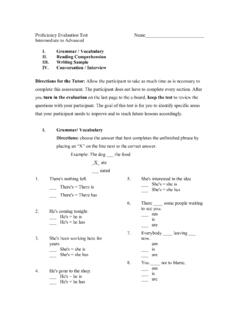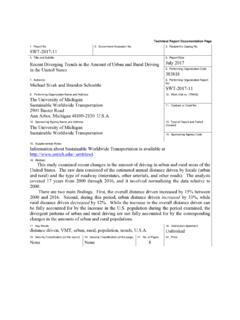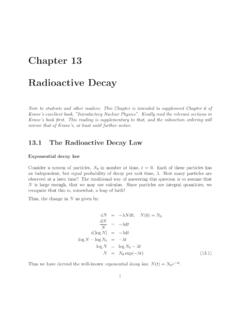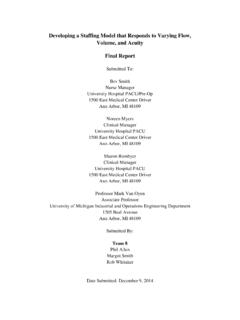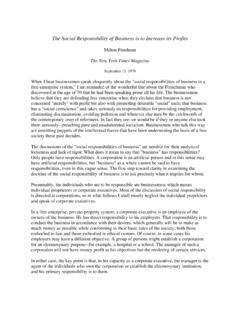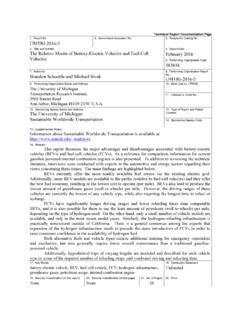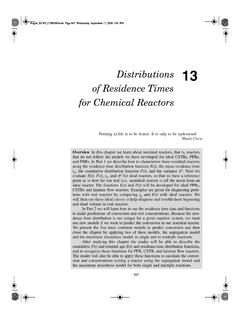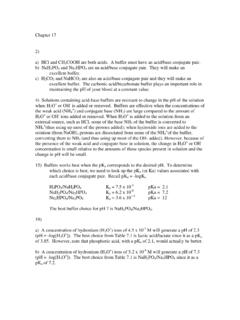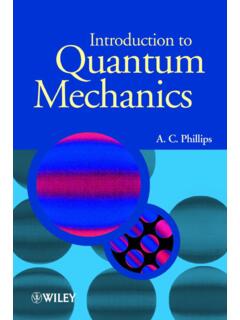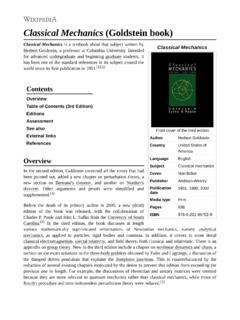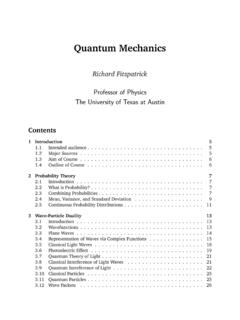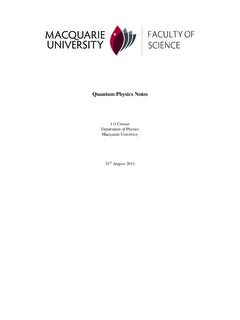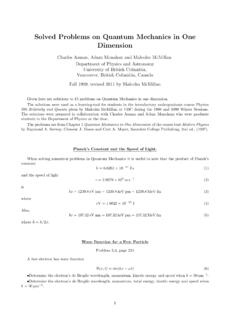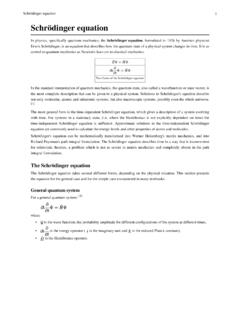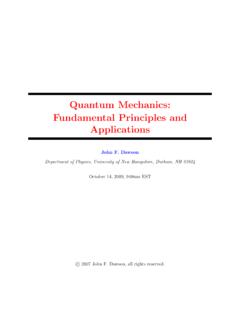Transcription of 5. The Schrodinger equation
1 5. The Schro dinger equation The previous the chapters were all about kinematics how classical and relativistic parti- cles, as well as waves, move in free space. Now we add the influence of forces and enter the realm of dynamics . Before we take the giant leap into wonders of quantum mechanics , we shall start with a brief review of classical dynamics. Elements of Nuclear Engineering and Radiological Sciences I NERS 311: Slide #1. Classical 1D motion under the influence of a potential In 1 dimension (2, if you count time), the equation of motion of a mass with kinetic energy K, under the influence of a time-independent potential, V (x), is, in classical physics, given by the energy balance equation : E = K + V (x) ( ). 1 2. = mx + V (x) ( ). 2. where E, the sum of the energy associated with the motion of the particle, and it's potential energy at its location, is a constant of the motion . Thus, when the particle is in motion, the energy is being transferred between K and V . To see how the equation of motion is developed, dtd of ( ).
2 1 dV dV. 0 = 2mx x + x = mx + x . ( ). 2 dx dx The zero results since E is a constant, and the V term arises since it is implicitly dependent on t, through the particle position, x. Elements of Nuclear Engineering and Radiological Sciences I NERS 311: Slide #2. Classical 1D motion under the influence of a potential There are two solutions: x = 0 . ( ). This is statics . This is for Civil Engineers. (Buildings are not supposed to move.). The other is dynamics: dV. mx + =0, ( ). dx which when you replace dV /dx by F (x), is recognized as Newton's 2nd Law of Motion. This is a 2nd-order, ordinary differential equation (ODE), that yields complete knowledge of v(t) = x (t) and x(t) given knowledge of any two positions, or any two velocities, or any combination of two, at any time. Elements of Nuclear Engineering and Radiological Sciences I NERS 311: Slide #3. The harmonic oscillator .. For this case, the ideal harmonic oscillator, which is conveniently represented by a spring1 , the potential and force are: 1.
3 V (x) = kx2 , ( ). 2. dV. F (x) = = kx , ( ). dx where k is the spring constant . The larger the k, the stronger the spring. Elements of Nuclear Engineering and Radiological Sciences I NERS 311: Slide #4. 1. OK, it is a very idealized spring. The spring is massless, there are no dissipative forces in the spring, it's attached to something infinitely heavy just floating there, the whole assembly is in vacuum, it all happens in one dimension, and there's no gravity! Other than that, it's pretty realistic! .. The harmonic oscillator .. V(x) and F(x). V(x). F(x). x_0 0 x_0. V (x) and F (x) are plotted above. m moves along x between the turning points , x0. Note that the force always pulls the mass back toward the origin. Elements of Nuclear Engineering and Radiological Sciences I NERS 311: Slide #5.. The harmonic oscillator .. Let's obtain the equations of motion: From ( ). dV. 0 = mx +. dx = mx + kx (substituted for V (x)). = x + 2x , ( ). q where mk , which has the dimension of frequency (T 1).
4 ( ) has the general solution: x(t) = A sin t + B cos t , ( ). where A and B are constants that are fixed by the initial conditions. Elements of Nuclear Engineering and Radiological Sciences I NERS 311: Slide #6.. The harmonic oscillator .. There are many ways to do this, but let's choose that following: At t = 0, set x = 0. That forces us to set B = 0. Now we can write: x(t) = x0 sin t , ( ). x (t) = x0 cos t or, ( ). v(t) = v0 cos t , ( ). and the equations of motion are known. x0 is the classical turning point . We know that |x(t)| x0. where the mass stretches the spring to its limit, and it comes temporarily, to rest, that is, at t = 2 , 3 , 5 .. , x(t) = x0. 2 2. v0 is the maximum speed . We know that |v(t)| v0, where the mass passes through the origin, and reaches its maximum speed, that is, at t = 0, , 2 .. , v(t) = v0. Elements of Nuclear Engineering and Radiological Sciences I NERS 311: Slide #7.. The harmonic oscillator .. This allows us to write the energy balance equation as: E = K + V (x).
5 1 1. = m[v(t)]2 + k[x(t)]2. 2 2. 1 2 2 1 2 2. = mv0 cos t + kx0 sin t , ( ). 2 2. 1 1. = mv02 = kx20 . ( ). 2 2. 1. Since hsin2()i = hcos2()i = 2 we can also write: E. hKi = hV i = . ( ). 2. This means that the spring is a machine that equipartitions the kinetic energy and the potential energy, when averaged over time. We shall see this in quantum mechanics soon! Elements of Nuclear Engineering and Radiological Sciences I NERS 311: Slide #8. Forecasting quantum mechanics with the oscillator .. Although, this is a completely classical system, let's see what happens when we ask it questions that resemble the kinds of questions we would ask of matter waves . What are hxi, hx2i, hpi = hmvi, hp2i? Since the average position is zero, and the system is, on average, stationary we know: hxi = hpi = 0 . ( ). And, since E 1. = hKi = mhv 2i , 2 2. and E 1. = hV i = khx2i , 2 2. E. hp2i = mE ; hx2i = . ( ). k Therefore, . r p 2 2. p 2 2. E E E. p x = hp i hpi hx i hxi = mE =p = ( ). k k/m.
6 Elements of Nuclear Engineering and Radiological Sciences I NERS 311: Slide #9.. Forecasting quantum mechanics with the oscillator Later on, in quantum mechanics , we will find that the ground state (lowest energy solution). has energy E = ~2 , for which ~. p x = , ( ). 2. that has the lowest value allowed by quantum mechanics . And, if I told you that the ground state wave function is a Gaussian, would you be surprised? Elements of Nuclear Engineering and Radiological Sciences I NERS 311: Slide #10. Justifying the Schro dinger equation .. Recall our representation of a matter wave from the previous chapter2 : Z + . 1 i[kx (k)t]. A(x, t) = dk A(k)e . ( ). (2 )1/2 . Recall as well, that our x-space operator for the wavenumber was found to be: . k = i . ( ). z (We'll use the symbol to denote that the object is an operator in either the x-space or the k-space, rather than a function. It should be clear, from the form of the operator, what space it is operating on.). Since, for waves, p = ~k, it is reasonable to assume that the momentum operator is given by.
7 P = i~ , ( ). x since Z + . 1 i[kx (k)t]. p A(x, t) = i~ A(x, t) = dk (~k)A(k)e . ( ). x (2 )1/2 . Elements of Nuclear Engineering and Radiological Sciences I NERS 311: Slide #11. 2. In this chapter the 1D space variable will be x, rather than z. At some point I will make them uniform.. Justifying the Schro dinger equation .. Following the same logic: ~2 2. K = 2. , ( ). 2m x since 2 2 Z + 2 2 . ~ 1 ~k i[kx (k)t]. K A(x, t) = A(x, t) = dk A(k)e , ( ). 2m x2 (2 )1/2 2m for the kinetic energy, and . E = i~ , ( ). t since Z + . 1 i[kx (k)t]. E A(x, t) = i~ A(x, t) = dk [~ (k)]A(k)e , ( ). t (2 )1/2 . for the total energy. Elements of Nuclear Engineering and Radiological Sciences I NERS 311: Slide #12.. Justifying the Schro dinger equation .. In analogy with Classical Physics, where: K +V =E , ( ). Schro dinger hypothesized that the non- relativistic wave equation should be: K (x, t) + V (x, t) (x, t) = E (x, t) , ( ). or ~2 2 (x, t) (x, t). + V (x, t) (x, t) = i~ . ( ). 2m x2 t Voila!
8 One Nobel Prize! ( ) is the equation that describes the motion of non- relativistic particles under the influence of external forces. The trajectory in Classical mechanics , viz. x(t) and v(t) are replaces by the wave amplitude, (x, t), and the attributes we associate with (x, t). Elements of Nuclear Engineering and Radiological Sciences I NERS 311: Slide #13. Take the Schro dinger equation , that is intrinsically complex, with complex 2-part solutions, ~2 2 (x, t) (x, t). 2. + V (x, t) (x, t) = i~ , 2m x t and its expectation value that yields the conservation of energy equation . h |K | i + h |V | i = h |E |i The potential in the above equation is real, for now. Henceforth functional dependencies will be repressed. Now, split () into real and imaginary parts, viz. () = R() + i I() and see what results for these equations. ~2 2 (x, t) (x, t). + V (x, t) (x, t) = i~. 2m x2 t Now taking the expectation values of the above gives h |K | i + h |V | i = h |E | i Substituting this into the above gives two coupled differential equations, and shows the con- nection between the real and complex parts of and a new looking energy conservation equation .
9 Elements of Nuclear Engineering and Radiological Sciences I NERS 311: Slide #14. For the differential equations: ~2 2 R I. 2. + V R = ~ , 2m x t 2 2. ~ I R. = ~. 2m x2 t Note that both equations contain R and I. For the Conservation of Energy equation : h R|K | Ri + h I|K | Ii + i[h R|K | Ii h I|K | Ri] Kinetic energy +. h R|V | Ri + h I|V | Ii + i[h R|V | Ii h I|V | Ri] Potential energy =. h R|E | Ri + h I|E | Ii + i[h R|E | Ii h I|E | Ri] Total energy Elements of Nuclear Engineering and Radiological Sciences I NERS 311: Slide #15. The Schro dinger equation : norm , one particle . Important concept: the norm associates (x, t) with one particle . The association of one particle is associated with the norm of (x, t). We require that (x, t) be normalized so that: Z + . 1= dx (x, t) (x, t) . ( ).. Interpretation: That one particle is, somehow, smeared over all of space. This is the giant leap that quantum mechanics takes. There is no concept of this in Classical mechanics . A. particle is described as a point in space x(t), that moves in time.
10 Consequence: In order for ( ) to be true, the integral over all space, implied by that equa- tion, must exist. If the norm is undefined, 0 or , it cannot describe a particle. The norm is time-independent. Despite the time independence on the right hand side (RHS). of ( ) one can show (we will, later) that this is always true if the particle is moving in a real potential. Elements of Nuclear Engineering and Radiological Sciences I NERS 311: Slide #16. The Schro dinger equation : the probability current density . Where is the particle? . In Classical mechanics , the answer is: x(t). In quantum mechanics , the closest answer is | (x, t)|2. This quantity is called the probability density , P (x, t): P (x, t) = (x, t) (x, t) = | (x, t)|2 . ( ). Interpretation: Although the particle is smeared over all space with amplitude (x, t), we can definitely say that the likelihood of finding the particle at x is given by P (x, t). That is, if P (x1, t) > P (x2, t), we are more likely to observe the particle interacting with something at x1 rather than x2.
